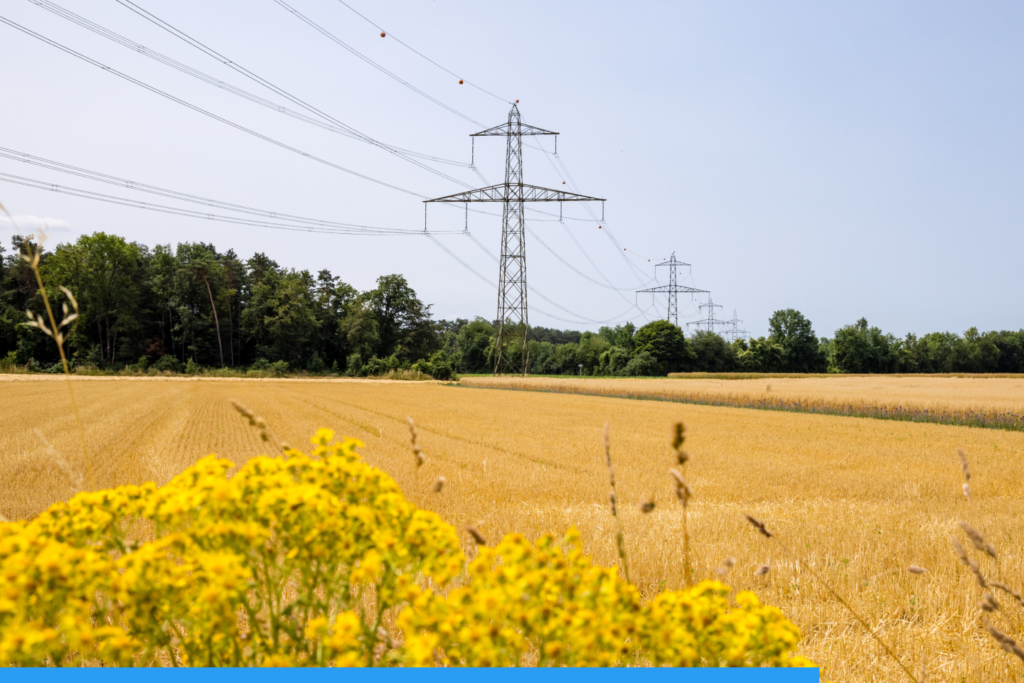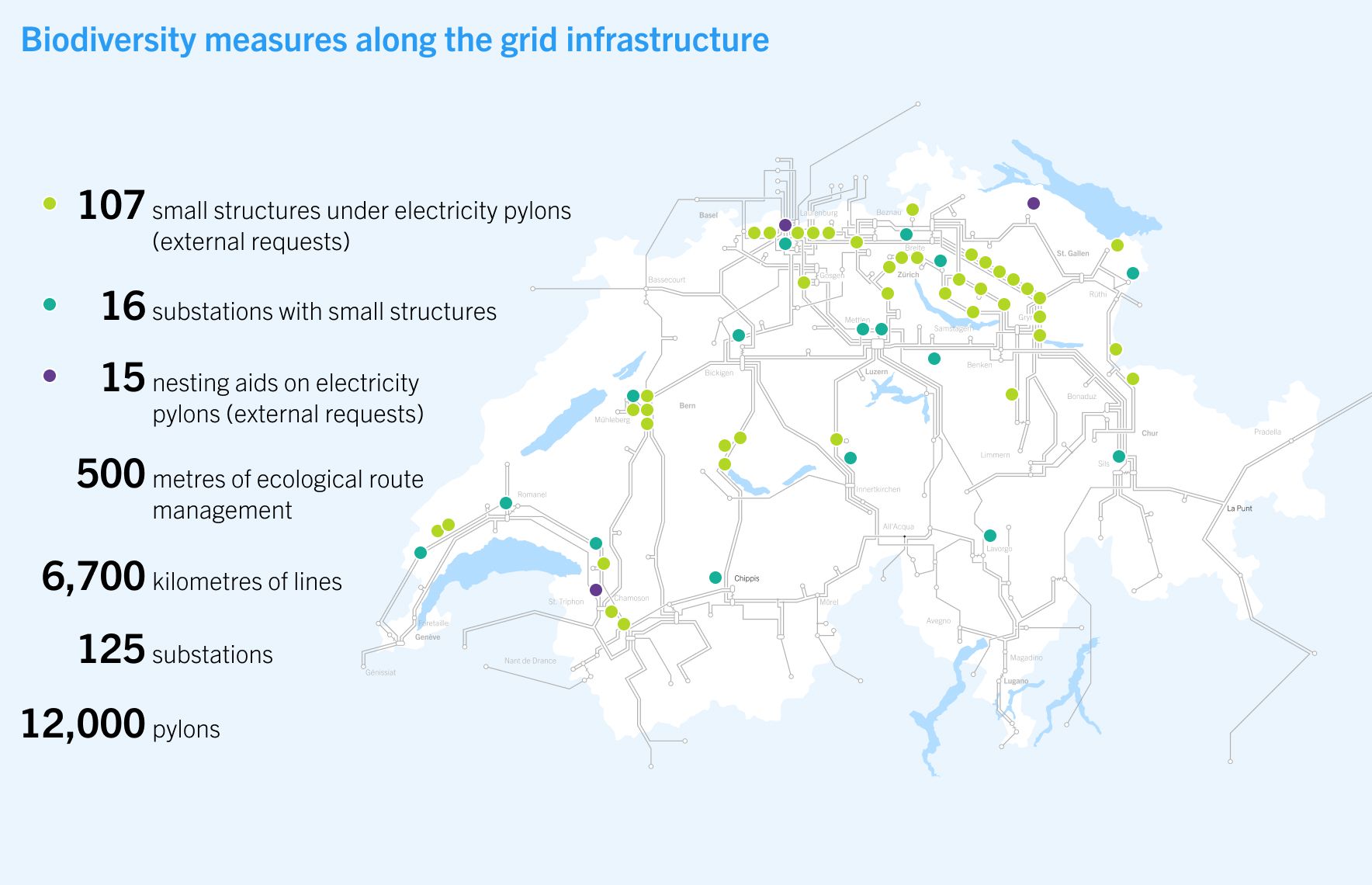| | Risk | Classification1 | Potential operational impact | Potential financial impact2 | Time frame3 | Measures |
| Physical climate risks | Acute | Increase in extreme weather events (e.g. storms, floods) | High | Damage to infrastructure with a potential impact on security of supply due to unexpected power outages | Moderate: additional costs due to repairs, reinforcements, relocations and/or maintenance work | K/M/L | • Regular hazard assessment by means of updated hazard maps |
| • Established processes in the area of business continuity management (see chapter «Mission») |
| • Monitoring of lines, partly by collecting weather data, and its impact on the infrastructure |
| Chronic | Thawing of the permafrost | Impact on the stability of the 33 pylons located in permafrost areas | • Targeted monitoring of pylon stability due to changes in permafrost soils |
| • Inclusion of risk in new planning |
| Rise in forest fires due to increasing dry weather | Threat to infrastructure from forest fires | • Vegetation management (see chapter «Environmental protection, biodiversity and circular economy») |
| • Specific use of operating facilities with increased fire resistance requirements |
| More rockfalls, landslides or avalanches | Damage to infrastructure (pylons and substations) with a potential impact on security of supply | • Regular hazard assessment by means of updated hazard maps |
| • Selective erection of protective structures |
| • Targeted real-time monitoring of pylons in landslide areas |
| • Cooperation with cantons and municipalities for stabilisation measures (e.g. Brienz landslide slope relief tunnel) |
| Change in snow and ice loads and shift in snow limits | Change in the static engineering requirements for overhead lines and structures in alpine areas; impact on the accessibility of installations in winter | • Verifications and, if necessary, adaptation of static engineering requirements during the planning stage |
| Transition risks | Political and legal | Lengthy procedures for the approval of grid projects | High | Slow expansion and modernisation of the grid with potential delays in the integration of renewable energy resources | Moderate: additional operational and legal expenses and costs due to delays | K/M/L | • Transparent information and involvement of affected population groups as part of stakeholder engagement (see chapter «Stakeholder engagement» )
• Commitment to more efficient approval processes to speed up grid renewal and expansion |
| Economic and social impact of delays and potential impact on Swissgrid’s reputation |
|
| Uncertain legal basis for the chargeability of Swissgrid’s emission reduction measures | Moderate | Impact on Swissgrid’s emissions reduction pathway with reputational and compliance risks | Moderate: lack of tariff reimbursement | K/M | • Regular dialogue with the regulatory authority, Swissgrid shareholders and stakeholders |
| • Examination of specific options as part of CSER strategy development |
| New regulatory requirements for the use of SF6 | Moderate | Impact on the planning and maintenance of operating facilities with SF6, including risks in terms of system availability, cost increases and time horizons | Moderate due to higher procurement costs | K/M/L | • Measures to reduce SF6 emissions (see chapter «Emission reduction measures and effectiveness») |
| Technological | Increasingly volatile electricity generation due to the growing proportion of renewable energies | Medium to high | More demanding planning and greater vulnerability / higher risks for grid stability | Medium to high | M/L | • Measures as part of «Grid transfer capacity» (see chapter «2027 Strategy») |
| • Long-term planning for several years, «Strategic Grid 2040», and implementation of Swissgrid’s voltage maintenance concept |
| • Improvement of forecasts, including corresponding data processing and decision bases (e.g. via mathematical algorithms) |
| • Closer cooperation and coordination with grid operators in Europe and Switzerland |
| Market and reputation | Stricter requirements for sustainability reporting and target setting, including in climate protection | Low | Further development of the standards for sustainability reporting (Swiss, EU and ESG rating agencies) with a different focus in some cases; this increases the requirements for Swissgrid’s data and information management and harbours reputational and compliance risks | Moderate due to effects on capital procurement and Swissgrid’s operating expenses | K/M | • Optimisation of data collection processes for 2023 and 2024 |
| • External and internal «health checks» on the maturity of non-financial reporting (2023 and 2024) |
| • Development of an internal control system for non-financial reporting |
| • Exchange of experience and cooperation with industry partners and affected companies |

